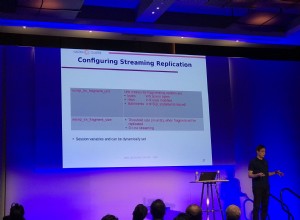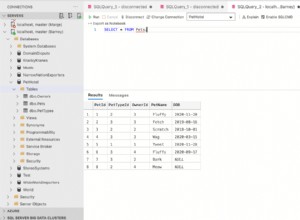Per ottenere il risultato, dovrai cercare di annullare il pivot dei dati nel Total e Volume colonne prima di applicare la funzione PIVOT per ottenere il risultato finale. Il mio suggerimento sarebbe di scrivere prima una versione hardcoded della query, quindi convertirla in SQL dinamico.
Il processo UNPIVOT converte queste colonne multiple in righe. Ci sono alcuni modi per UNPIVOT, puoi usare la funzione UNPIVOT o puoi usare CROSS APPLY. Il codice per annullare il pivot dei dati sarà simile a:
select id,
col = cast(t_year as varchar(4))+'_'+t_type+'_'+col,
value
from ATM_TRANSACTIONS t
cross apply
(
select 'total', total union all
select 'volume', volume
) c (col, value);
Questo ti dà i dati nel formato:
+-----+---------------+-------+
| id | col | value |
+-----+---------------+-------+
| DD1 | 2008_A_total | 1000 |
| DD1 | 2008_A_volume | 10 |
| DD1 | 2008_B_total | 2000 |
| DD1 | 2008_B_volume | 20 |
| DD1 | 2008_C_total | 3000 |
| DD1 | 2008_C_volume | 30 |
+-----+---------------+-------+
Quindi puoi applicare la funzione PIVOT:
select ID,
[2008_A_total], [2008_A_volume], [2008_B_total], [2008_B_volume],
[2008_C_total], [2008_C_volume], [2009_A_total], [2009_A_volume]
from
(
select id,
col = cast(t_year as varchar(4))+'_'+t_type+'_'+col,
value
from ATM_TRANSACTIONS t
cross apply
(
select 'total', total union all
select 'volume', volume
) c (col, value)
) d
pivot
(
max(value)
for col in ([2008_A_total], [2008_A_volume], [2008_B_total], [2008_B_volume],
[2008_C_total], [2008_C_volume], [2009_A_total], [2009_A_volume])
) piv;
Ora che hai la logica corretta, puoi convertirlo in SQL dinamico:
DECLARE @cols AS NVARCHAR(MAX),
@query AS NVARCHAR(MAX)
select @cols = STUFF((SELECT ',' + QUOTENAME(cast(t_year as varchar(4))+'_'+t_type+'_'+col)
from ATM_TRANSACTIONS t
cross apply
(
select 'total', 1 union all
select 'volume', 2
) c (col, so)
group by col, so, T_TYPE, T_YEAR
order by T_YEAR, T_TYPE, so
FOR XML PATH(''), TYPE
).value('.', 'NVARCHAR(MAX)')
,1,1,'')
set @query = 'SELECT id,' + @cols + '
from
(
select id,
col = cast(t_year as varchar(4))+''_''+t_type+''_''+col,
value
from ATM_TRANSACTIONS t
cross apply
(
select ''total'', total union all
select ''volume'', volume
) c (col, value)
) x
pivot
(
max(value)
for col in (' + @cols + ')
) p '
execute sp_executesql @query;
Questo ti darà un risultato:
+-----+--------------+---------------+--------------+---------------+--------------+---------------+--------------+---------------+--------------+---------------+--------------+---------------+
| id | 2008_A_total | 2008_A_volume | 2008_B_total | 2008_B_volume | 2008_C_total | 2008_C_volume | 2009_A_total | 2009_A_volume | 2009_B_total | 2009_B_volume | 2009_C_total | 2009_C_volume |
+-----+--------------+---------------+--------------+---------------+--------------+---------------+--------------+---------------+--------------+---------------+--------------+---------------+
| DD1 | 1000 | 10 | 2000 | 20 | 3000 | 30 | 4000 | 40 | 5000 | 50 | 6000 | 60 |
| DD2 | 7000 | 70 | 8000 | 80 | 9000 | 90 | 10000 | 100 | 11000 | 110 | 1200 | 120 |
+-----+--------------+---------------+--------------+---------------+--------------+---------------+--------------+---------------+--------------+---------------+--------------+---------------+




